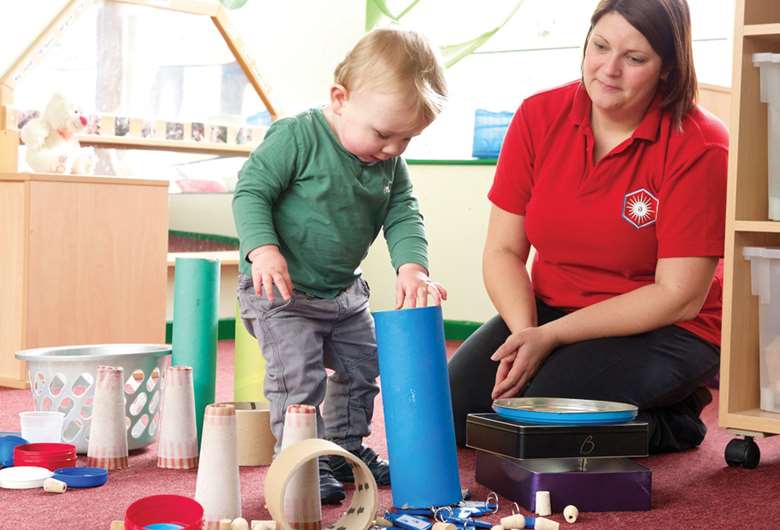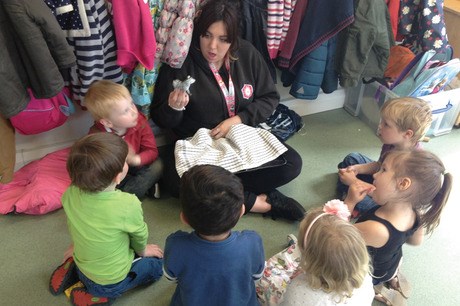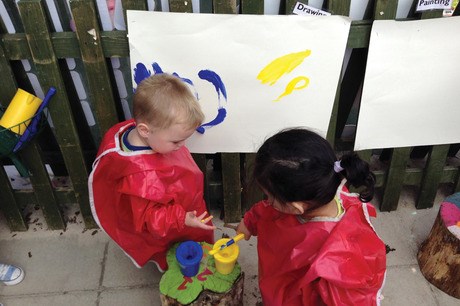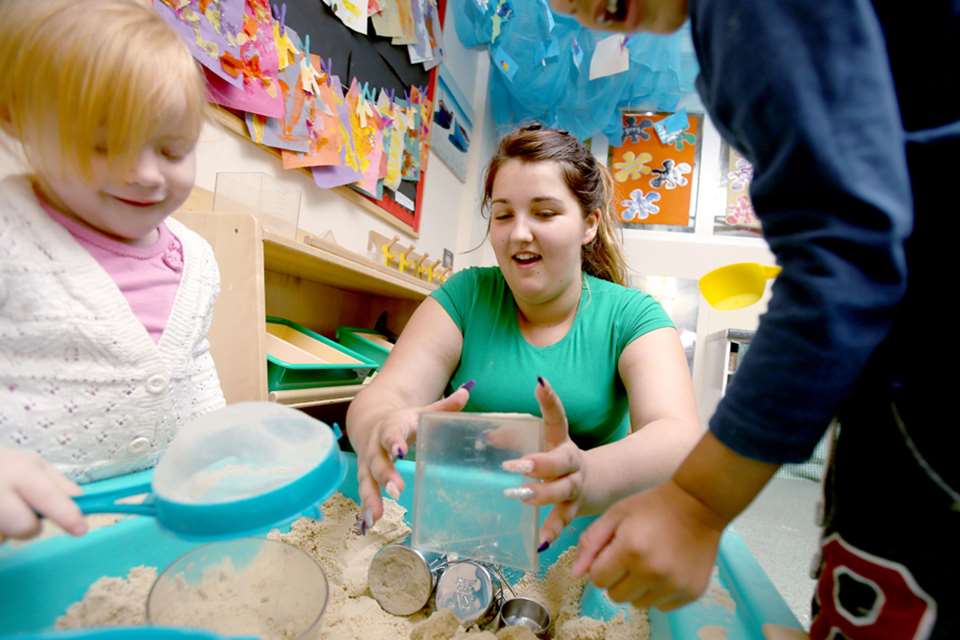Positive Relationships: Behaviour - By numbers
Annette Rawstrone
Monday, December 14, 2015
The sector is struggling to develop staff teams that meet the needs of two-year-olds, though some are making great strides. Annette Rawstrone talks to one nursery about its road to Outstanding

Soon after manager Julie Ayrton joined what is now Ark Alpha Nursery, in Portsmouth, it experienced an influx of two-year-olds. This was due to the start of the funded places programme for twos and the decision to restructure the age ranges within the nursery’s rooms to create more places. But the quick doubling of two-year-old numbers was stressful.
Many of the children were entering the nursery, which is based in a deprived area of the city, with limited communication and social skills. As a result, the typical behaviour of two-year-olds – being constantly on the move, not yet able to share, and needing regular comfort and support – was exacerbated, affecting how they settled as well as their interactions.
Mrs Ayrton explains, ‘Their developmental stage meant that they got frustrated quickly, and a lack of communication skills resulted in them resorting to negative behaviour to express themselves. We noticed that we were going through many bouts of dealing with children who were biting, tantrums and children who were generally hitting out and throwing.’
Organisation and practice within the room, which now had 20 two-year-olds in it, added to the tensions. While the nursery always worked within ratio and allocated a key person to each child, in reality the staff worked as one large group.
As well as contributing to behavioural problems, this approach also left staff less able to respond to the individual needs of the children, who could be almost 12 months apart in age. Another factor was the limited amount of free flow, with everyone either inside or outside at any one time and all tidying up together.
‘Having a big increase in the numbers of two-year-olds highlighted existing problems,’ says Mrs Ayrton. ‘So staff were constantly firefighting to manage the children and tackle issues rather than playing and enjoying work. This resulted in stressed staff and unhappy children.’
Ark Alpha Nursery turned around staff morale and children’s behaviour after calling in an early years consultant
‘Having a big increase in the numbers of two-year-olds highlighted existing problems’
Bringing about change was difficult, explains Mrs Ayrton, partly because hands-on training for areas of practice such as working with two-year-olds was in short supply.
However, she adds, ‘As part of our professional development, we started to look at Ofsted’s early years inspection guidance and reflected on our practice. We talked through what practice was achieving a Good and what needed improving, and then looked at what we needed to put in place and develop to achieve an Outstanding. We started to visit local Outstanding nurseries for inspiration and to share practice.’
Then, in September 2013 – when Ark, an education charity operating a network of academies, took over the nursery – early years consultant Penny Tassoni was asked to support practitioners in developing a new way of working with the two-year-olds.
MAKING CHANGES
‘We welcomed Penny into the setting and spoke to her about our development plans,’ explains Mrs Ayrton. ‘She agreed with the areas that we had identified for improvement and suggested further developments and strategies for better practice with the two-year-olds. Thankfully, these had a big impact on the way that we work with the children and support their emotional well-being.’
First, Ms Tassoni encouraged the setting to break the children into smaller groups in order to use the 1:4 ratio more effectively. So, rather than moving between many adults, the children could feel that they had a special adult that they shared with just three others, leading to a greater sense of security.
‘While it is typical for two-year-olds to have tantrums and find sharing difficult, the frequency of these behaviours is likely to increase when children are feeling insecure,’ says Ms Tassoni. ‘By being with a consistent adult who is responsive to them, their needs can be met immediately.
‘I have found that where group care settings use their 1:4 ratio with the two-year-olds in tighter groups, they report fewer instances of problems settling in and problem behaviour such as biting and hitting.
‘Most young two-year-olds will not allow their own parent to go to the toilet by themselves, so why should we think that they will disappear into a large room and float around happily if they won’t even do that in a familiar environment such as home?’
By giving staff responsibility for four children and doing plenty of what Ms Tassoni terms ‘mother ducking’ – supporting and following around a small number of children – her guidance, alongside the earlier practice changes, gradually made a huge difference to the children’s behaviour.
Practitioners came to realise that adapting to being one of two or three siblings at home to one of 20 children in the nursery was daunting for the children, and could only result in them not settling well and exhibiting distressed behaviour.
Staff stopped large group activities and introduced a day that was more fluid, with children moving around the setting to different activities, both inside and outside – effectively doubling the usable space.
‘By being dispersed around the setting, behavioural issues were limited because there was more room and more for the children to do. They were not expected to engage together closely and share limited resources. It became a much more involving environment,’ says Mrs Ayrton.
‘Also, by giving staff the ownership of a small group of children, and children the ownership of the staff, it actually quartered the practitioners’ stress levels. They got to know the children better because they were in more of an intensive group and the children felt more secure in their boundaries.
‘Closer interactions between staff and children meant that staff could quickly pick up on warning signs – such as that a child was getting frustrated and may hit out – and use diversionary tactics to help prevent poor behaviour.
‘Penny’s visit also inspired practitioners to extend her suggestions and ideas and conduct research of their own to help further develop practice, room layout, structure, activities and resources, giving the children a varied and exciting environment each day,’ she adds.
EMBEDDING CHANGE
‘It took around six months to embed the changes and work out the kinks, such as the logistics of covering for staff when they are tackling other things including changing nappies, doing paperwork or sterilising toys. We try to have a spare member of staff, but that is not always financially viable so I also need to co-ordinate the day closely with deployment sheets,’ says Mrs Ayrton.
‘Then there were a few months when staff lapsed into their old ways and we soon saw the children’s behaviour escalate again.’ Staff reflected on their practice, reworked systems and have now been consistent in the small group working for around 18 months.
The children are now engaged in more purposeful play, and staff know them more intimately.
The children now engage in more purposeful play, adds Mrs Ayrton, and the practitioners can use their intimate knowledge of individuals to do more detailed observations in order to plan and target better.
Staff have also developed the language they use with all children, now considering how they speak to the children and give commands. Instead of presuming that children are being deliberately disobedient, they try to say a child’s name and make eye contact to ensure they have their attention before giving an instruction and use more directive language.
Rather than telling children what not to do, such as ‘Don’t run’, they now focus on the positive and give a clearer instruction: ‘Walk please’. They try to correct behaviour quickly and tell children what they are expected to do rather than what they are doing wrong, and use distraction techniques. ‘It is a tricky age and consistency is key,’ says Mrs Ayrton. ‘If children are not too sure what they are meant to be doing then they don’t do it effectively, or avoid doing it at all. Being careful to explain clearly helps behaviour.’
While days are still busy for practitioners, morale is now much higher as a result of the changes. Mrs Ayrton says, ‘No-one likes change, but this really had to happen. The children have settled down, we’re striding forward always looking at ways of improving our practice and the service we provide to families, and we were very proud to achieve an Outstanding in our last Ofsted report.’










